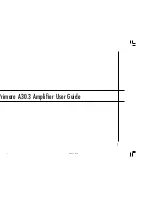
The material contained in this document is the property of Electronics & Innovation Ltd., it is
subject to change without notice.
May 2016
11
Revision G
step attenuator (CCW) so that the output is reduced by 50 dB.
g)
Reconnect the 3100LA into the test set-up of Figure 4-1.
h)
Place the 3100LA power switch to the "ON" position.
i)
Observe the gain versus frequency sweep on the oscilloscope.
The average gain should be greater 50 dB
The gain variation should be within the 3 dB as shown on the
oscilloscope.
4.4.2 Measurement of Harmonics
Figure 4-2.
1.) Equipment Required:
a)
Sweep/Signal Generator
b)
Calorimetric Power Meter HP435B
c)
Spectrum Analyzer.
d)
Attenuator (30dB)
e)
Coupler (30 dB)
2.)
Connect the Equipment as shown in Figure 4-2, then proceed as follows:
a)
Adjust the signal generator to a CW center frequency of 250 kHz, for an
indicated output of 100 watts on the power meter.
b)
Using the spectrum analyzer, check that the level of the carrier
harmonics is less than -25 dB with respect to the carrier while manually
scanning the frequency band of 250 KHz to 150 MHz. An indicated
power output of 100W should be maintained during this operation.
30 dB Attenuator
Sweep Generator
RF Output
150 KHz
– 150 MHz
Spectrum
Analyzer
Power Meter
30 dB
coupler






























